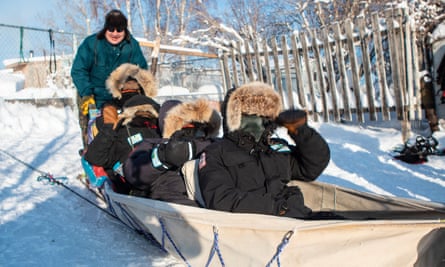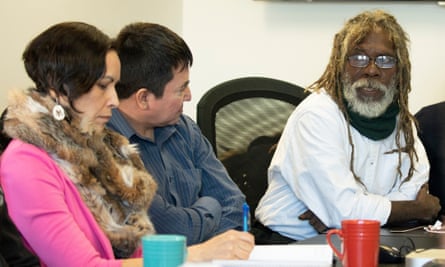Dean Yibarbuk is a very long way from home, standing in the snow in Yellowknife in the Northwest Territories of Canada with only his eyes visible through layers of winter gear. It’s -36C.
Yibarbuk is a traditional owner of Djinkarr, near Maningrida in Arnhem Land. He’s a scientist and a senior ranger with Warddeken, the Aboriginal-owned, not-for-profit company looking after country using traditional fire management practices to deal with climate change.
Yibarbuk and his fellow travellers, including David Ross, director of the Central Land Council in Alice Springs, are about to hop on a dogsled, a traditional form of transport for their hosts, the Dene First Nations.
The climate difference they have travelled through is stark: in central Australia, where David Ross lives, temperatures have been over 40C for weeks this summer, and they’ve arrived in the middle of a polar vortex.
“This is like being in the movies,” Ross says through his balaclava. “It’s a whole different world. Hats off to the mob who live this every day.”

Ross, Yibarbuk and senior Gunditjmara man Denis Rose have met with the Dehcho, Sahtu and Lutsel K’e First Nations, as well as the Canadian minister of environment and climate change, Catherine McKenna, to advise them on how to care for country, and why it works.
“It’s not just people turning up because there’s a dollar in it,” Ross says. “It’s because their heart’s in it and their emotion is there. It’s their country, it’s their identity, it’s their recognition of who they are, what they do, where they belong.”
The Trudeau government has promised to double the amount of protected land and sea in Canada by 2020, and has allocated $25m over the next five years to pilot 40 “Indigenous guardian” programs, inspired by Australia’s Indigenous rangers and protected areas.
“We say people need country and country needs people,” Yibarbuk says. “Particularly those Indigenous peoples who have been part of that country for thousands of years.
“What I am sharing with Canadians is that your culture and your elders are your strength, your youth are your future. Combine the two with your own responsibility to your traditional lands and sea, and that will give you power.
“When I think of guardians, I think back to ancestral law keepers and masters of songlines, keepers of the land and keepers of the ceremony. For me, guardians guide us to have everyday love for land management, night and day.”

“But make sure the government is playing its role in the partnership. You are delivering a great benefit for local communities but also the whole of Canada, in looking after the environment and culture,” he says.
Valerie Courtois is an Innu traditional owner from the Mashteuiatsh in central Québec, and runs the Indigenous leadership initiative, which is behind the push for on-country guardianship.
“When we have depended on piecemeal funding, I’ve spent 80% of the time on securing that funding. I would lose good staff because of the uncertainty. And all of that also means losing the chance to gain momentum,” Courtois says.
Dene man, Steve Nitah, agrees: “Guardians make a lot of sense in today’s world. The return on investment is significant. It has benefits environmentally, socially, culturally and economically.”
At home in western Arnhem land, Warddeken rangers use traditional fire management techniques to control the timing, intensity and scale of fires, and offset greenhouse gas emissions. They monitor biodiversity, care for important sites and manage weeds and feral animals.
Pew Trusts’ Patrick O’Leary has worked in conservation and environmental research, policy and advocacy for the last 30 years, 20 of them in remote Australia.
O’Leary says ranger programs are “high-value public investment” that can address closing the gap targets.
“Long-term partnerships [between traditional owners and governments] can pay off not only for the environment, but by providing local jobs, skill development, women’s employment, and more,” he says.
“Australia now has a world-leading example of Indigenous-led conservation and land management.
“I think Canada is at an exciting point for Indigenous conservation leadership. A lot has been achieved but there is much more to do.”